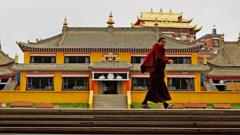As the Dalai Lama celebrates his 90th birthday, his followers express mounting anxiety over the future of Tibetan identity and autonomy. Recent reports from Sichuan province, particularly the Kirti monastery in Aba, illustrate the persistent struggles of Tibetans living under Chinese rule. A monk, shrouded in crimson robes and wary of government surveillance, articulated the dire situation: “Things here are not good for us."
The Kirti monastery has garnered both global recognition and distress for being a hub of Tibetan resistance. It was infamously noted in the late 2000s when a series of self-immolations took place as acts of defiance against oppressive Chinese policies. Despite Beijing’s efforts to pacify the Tibetan region through economic development and tourism, such attempts have often come with increased military presence and restrictions on freedoms, which local Tibetans have reported.
Communist Party rule, firmly entrenched for over 75 years since the annexation of Tibet in 1950, characterizes the existing relationship between the Chinese authorities and the Tibetan populace. The Dalai Lama is regarded by Beijing as a separatist, and those expressing solidarity with him risk incarceration. In this tense environment, a determined monk advised journalists to exercise caution, citing the ever-watchful eyes of state authorities.
The recent anniversary of the Dalai Lama's birth has catalyzed discussions surrounding his succession plan, as he emphasized the need for careful procedures in choosing a successor. As tensions grow, Tibetans are left to grapple with the dual realities of their potential future leaders, particularly in light of China's ambitions to control the narrative surrounding the next Dalai Lama.
Amidst the celebrations in exile and the ongoing silence in Tibet, the streets of Aba tell a different story. The recent imposition of laws surrounding education has introduced compulsory state-run schooling in Mandarin for Tibetan children, erasing cultural teachings and limiting their exposure to their own language and heritage. Critics argue that such measures will have long-term repercussions on Tibetan Buddhism and identity—potentially setting the stage for a complete cultural assimilation.
As visitors flock to Tibet, contemporary Chinese developments in the region contrast sharply with a historical legacy rich in spirituality and struggle. The omnipresent surveillance and restrictions create an atmosphere of fear, yet Tibetans display resilience—a community singing prayers, struggling to maintain their identity in the face of an imposing state.
The path forward remains clouded with uncertainty. The showcasing of Tibetan culture has been co-opted by Chinese propaganda, which presents a controlled version of Tibetan spirituality that the government feels is safe. This cultural manipulation creates a dilemma for Tibetans, who fear for the future of their beliefs, ways of life, and the very essence of their identity as the Dalai Lama’s passing approaches.
As the Tibetan people continue to cultivate their history and identity under duress, a critical challenge looms: how will they preserve their spiritual legacy when the embodiment of their faith, their leader, is no longer present? The question of who will succeed the Dalai Lama holds profound implications not only for Tibet but for global perceptions of autonomy, governance, and resilience within minority cultures.



















